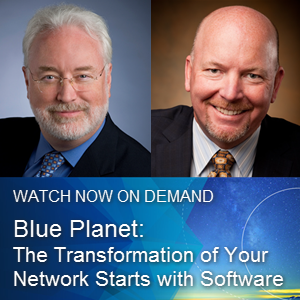Ciena Blue Planet unveils the dawn of service orchestration
Today Ciena’s Blue Planet division unveiled an entirely new architecture, a disruptive set of enhancements for our Blue Planet solution that change the way technologies like SDN and NFV are implemented to create open and programmable software-driven networks. We’re calling it the dawn of service orchestration. While Blue Planet has only been a part of the Ciena family for a few months, our R&D team has been hard at work on this new architecture for over a year, adding a set of innovative building blocks that bring SDN, NFV and service orchestration into a unified, open platform. So what are these new building blocks and what do they do? Joe Cumello goes through each of them in this blog post.
This is the first in a series of posts highlighting Blue Planet’s new architecture and features. Other posts:
- TOSCA and YANG? It’s not either/or…it’s both
- Apply BPMN to Enable Network Transformation at the OSS
- Behind the scenes with Ciena's new Blue Planet architecture
- What is the "Right" Approach to Open Source?
- Four Reasons You Want a Micro-Services Architecture
Today Ciena’s Blue Planet division unveiled an entirely new architecture, a disruptive set of enhancements for our Blue Planet solution that change the way technologies like SDN and NFV are implemented to create open and programmable software-driven networks.
We’re calling it the dawn of service orchestration. Cue the cool music.
While Blue Planet has only been a part of the Ciena family for a few months, our R&D team has been hard at work on this new architecture for over a year. Our core values aren’t changing. Ciena’s Blue Planet retains the programmable and vendor-agnostic principles that made it an industry leader in SDN and NFV with customers around the world.
 What Blue Planet now adds is a set of innovative building blocks that bring SDN, NFV and service orchestration into a unified, open platform. This platform both reduces vendor lock-in and simplifies the creation, automation, and orchestration of services for network operators across their end-to-end network. It’s a new way to look at network virtualization.
What Blue Planet now adds is a set of innovative building blocks that bring SDN, NFV and service orchestration into a unified, open platform. This platform both reduces vendor lock-in and simplifies the creation, automation, and orchestration of services for network operators across their end-to-end network. It’s a new way to look at network virtualization.
So what are these new building blocks and what do they do? Let’s go through each of them.
First, Blue Planet is now built upon a container-based micro-services architecture. This is the same modular design concept that companies like AT&T have said they will build their future networks around, allowing for rapid development and customization of new applications, including 3rd party and open-source apps. This micro-services architecture gives Blue Planet the flexibility to support a variety of use cases that include SDN Management and Control, NFV Orchestration, and Multi-Domain Service Orchestration – all from the same platform.
Blue Planet also equips providers with the ability to do their own “DevOps” style of self-service resource modeling. Using TOSCA-based Service Templates, a network operator can quickly create, deploy and enhance services without the traditional reliance on expensive OSS professional services.
Of course, none of this matters if you can’t support and bill for these new services with your existing OSS/BSS systems. That’s why we’ve simplified and streamlined this integration through the use of the Business Process Modeling and Notation (BPMN) standard.
Breaking down the software silos
You might be asking yourself why all these new “building blocks” are needed. Didn’t we just start virtualizing networks using SDN and NFV technologies…and now I’m here talking about a whole new virtualization model?
It turns out in the industry’s rush to tear down those age-old hardware silos we’ve all been complaining about for decades, we started building virtualized software solutions that didn’t necessarily talk to each other very well in the grand scheme of things. So in fact, we’ve re-created the very problem for which we were trying to solve, only with software silos instead of hardware.

Blue Planet finally breaks down these silos once and for all -- enabling a truly open, software-defined, multi-vendor network. Blue Planet supports both Ciena and non-Ciena domains (e.g. access, metro, core, cloud) through the use of resource adapters to interface with a single multi-domain service orchestration layer.

And as is inherent in our DNA, Blue Planet is built on standards and open-source. In fact, Blue Planet now incorporates dozens of open-source code bases in our platform, and includes well-known standards like Docker, LINUX, TOSCA, BPMN, and Netconf/YANG. Additionally, open APIs expose critical data to northbound platforms in our software stack.
We’re on a mission to automate services from creation to delivery, across both physical and virtual domains. There is a ton of innovation packed into this Blue Planet update, and we see it as the dawn of something big. Feel free to post any questions you have in the comments section below. You can also watch an on-demand archive of our launch webinar hosted by Ciena CTO Steve Alexander and Kevin Sheehan, VP of Global Operations for our Blue Planet division.

